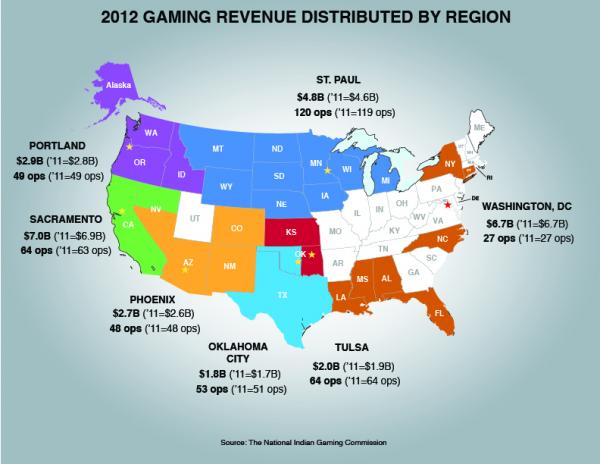By Gale Courey Toensing, Indian Country Today Media Network
An increase in Indian gaming revenues in 2012 of almost three percent offers “economic encouragements” for Indian country, according to the National Indian Gaming Commission (NIGC). The commission released data in late July showing revenues generated by the Indian gaming industry in 2012 totaled $27.9 billion—the third consecutive year of increases in gross gaming revenues (GGR) since the recession began in 2007.
The Indian gaming industry saw its largest gross gaming revenues ever in 2012, Tracie Stevens, NIGC chairwoman said. “The 2012 Indian gaming industry’s gross gaming revenues of $27.9 billion indicate a strong and mature Indian gaming industry. Additionally, gross gaming revenues in 2012 reached its highest level in history, ahead of 2011’s gross gaming revenues by $746 million. For those who judge casino spending as an indicator of increased discretionary spending and economic recovery, 2012 revenues certainly display economic encouragement,” Stevens said in a media conference in late July.
The National Indian Gaming Commission is an independent federal regulatory agency that was established by the Indian Gaming Regulatory Act of 1988. It provides training and technical assistance and regulatory oversight to ensure the integrity of more than 420 gaming establishments owned and operated by nearly 240 tribes across 28 states.

The NIGC calculates Indian gaming revenues based on a fiscal year. The 2012 GGR is calculated based on independently audited financial statements received by the NIGC through June 20, 2013. Financial statements are submitted by Indian gaming operations in accordance with the Indian Gaming Regulatory Act. Gaming revenues represent the net win from gaming activities, which is the difference between gaming receipts and payouts.
Yvonne Lee, director of finance for NIGC, explained, “First, it is important to note, gross gaming revenue, or GGR, is the amount wagered minus the winnings returned to players. GGR is the figure used to determine what a casino or other gaming operation earns before salaries, compact fees and other expenses are paid—the equivalent of sales, not profit. Gross gaming revenues should in no way be interpreted as profit-margin. These are revenues earned before paying other expenses.”
Last year’s GGR of $27.9 billion was 2.7 percent higher than the 2011 GGR of $27.2 billion. The NIGC data attribute the overall growth of revenues to 66 percent of the Indian gaming operations, which reported an increase in gaming revenues. Of the operations that reported an increase in revenues, approximately 44 percent showed moderate growth of less than 10 percent.
Associate Commissioner Dan Little said a key role in the growth of the Indian gaming industry was the commission’s review and updating of regulations. “Over the past three years our regulatory review has provided much needed reform to meet the needs of the changing industry and provide flexibility and consistency for tribes and tribal regulators,” Little said.
The 2003–2012 Gross Gaming Revenue Trends table shows the revenues trends over the past 10 years. Since 2010, the Indian gaming industry experienced approximately three percent annual growth—reaching its largest GGR this year.

Small and moderate gaming operations make up 56 percent of Indian gaming, the commission said. The Indian Gaming Regulatory Act determines how gaming revenues may be expended. Many Indian tribes use gaming revenues to fund economic development activities on reservations and to provide their citizens with social services, including health services, housing, early education programs and language and cultural preservation activities.
In 2012, 98 Indian gaming operations reported gaming revenues between copy0 million and $25 million, 70 Indian gaming operations reported gaming revenues between $3 million and copy0 million and 69 Indian gaming operations reported gaming revenues less than $3 million. Stevens said these numbers show that most tribal gaming operations are medium-sized or smaller. “The industry is driven by the demographics of each area. Most tribal gaming operations are in rural parts of the country where jobs are greatly needed for both Natives and non-Natives alike,” she said.
The map shown illustrates the seven NIGC regions across the country. All regions showed growth in revenues in 2012, continuing a trend that began in 2011. The largest increase in GGR of 5.1 percent or $233 million occurred within the St. Paul Region, which has 120 gaming operations across nine Great Plains states. The Tulsa Region, which has 64 gaming operations in Kansas and eastern Oklahoma, had the largest percentage increase from 2011—6.6 percent or copy25 million. There is also a chart that shows regional gross gaming revenue trends.
The NIGC calculates the Indian gaming industry’s gross gaming revenues data based on financial statements that are submitted by Indian gaming operations in accordance with the Indian Gaming Regulatory Act.
Read more at http://indiancountrytodaymedianetwork.com/2013/09/26/increases-gaming-revenues-bode-well-indian-country-151457

